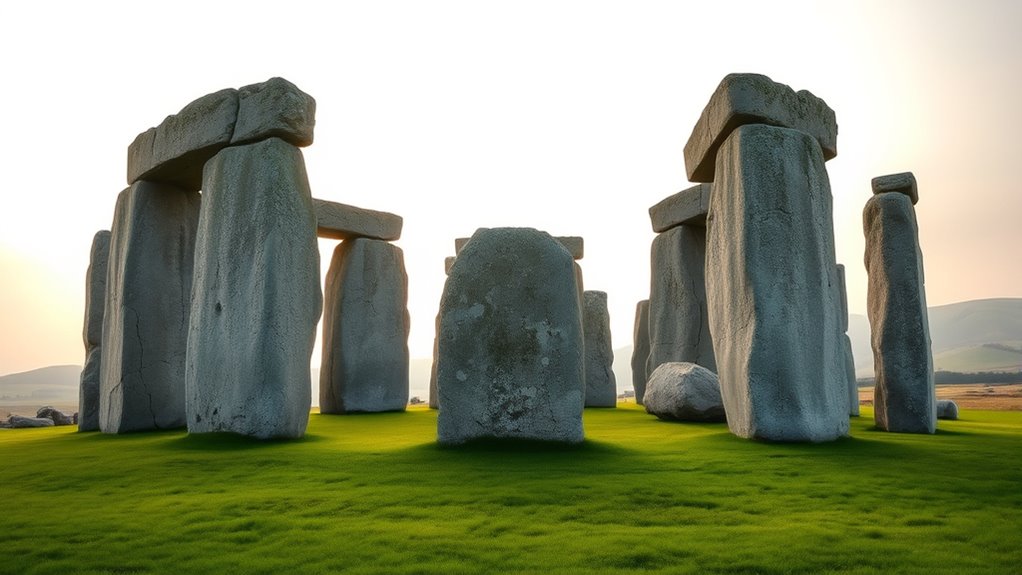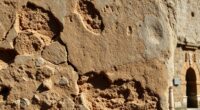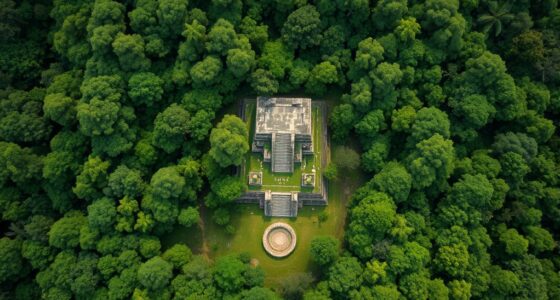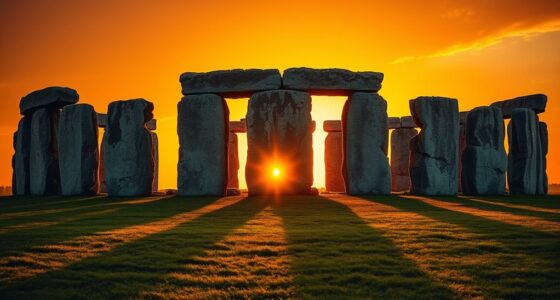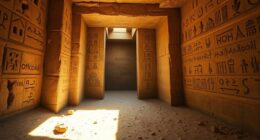Stonehenge was intentionally designed to harness sound, with its precise arrangement of stones creating resonance effects that amplify voices, chants, and ritual sounds. Standing inside or near the stones, you’d experience amplified acoustics that can enhance spiritual feelings and foster a sense of unity. These acoustic features suggest that sound played a pivotal role in ceremonies, making the experience more powerful. If you continue exploring, you’ll uncover how ancient engineers mastered the art of sound to shape sacred rituals.
Key Takeaways
- Stonehenge’s stone arrangement likely enhances sound resonance, amplifying vocalizations and chants during rituals.
- The site may function as a natural acoustic chamber, focusing and amplifying sound for ceremonial impact.
- Resonance effects foster a sense of unity and spiritual connection among participants during rituals.
- Ancient builders possibly designed the monument with intentional acoustic properties to influence ritual experiences.
- Sound manipulation at Stonehenge could have elevated spiritual states and reinforced collective participation in ceremonies.
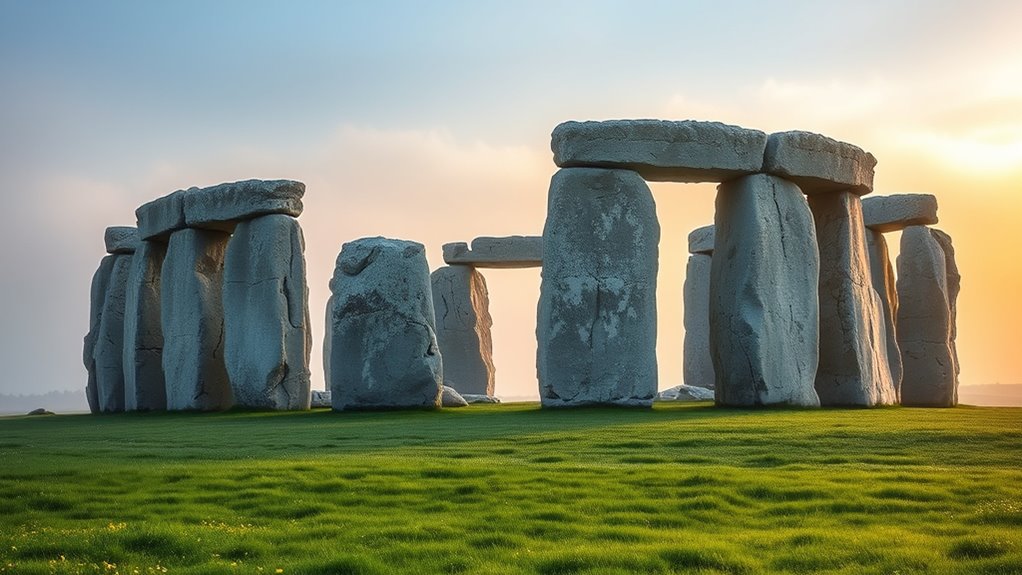
Have you ever wondered if Stonehenge was designed with sound in mind? It’s a fascinating idea, especially considering the site’s precise arrangement of massive stones. Some researchers believe that ancient builders understood principles of sound resonance and architectural acoustics, intentionally shaping the monument to influence how sound traveled and behaved within its space. When you think about it, the placement and orientation of the stones might not just have served visual or ceremonial purposes but also created unique acoustic effects that enhanced rituals or gatherings. This suggests that sound played a essential role in the ceremonies conducted here, shaping the experience in ways we’re only beginning to understand.
The concept of sound resonance is particularly intriguing in the context of Stonehenge. Resonance occurs when sound waves bounce within a space and reinforce certain frequencies, creating a richer, more powerful auditory experience. Some experiments have shown that standing inside or near the stone circle can amplify specific sounds, such as claps or vocalizations, making them resonate more intensely than they would in ordinary open air. This isn’t accidental; the design of the stones could have been optimized to produce desirable acoustic effects, turning the site into a kind of natural amplification chamber. This would mean that ritual chants, songs, or spoken words could be heard clearly and with greater impact over larger areas, fostering a sense of unity and spiritual connection among participants. Recognizing the architectural acoustics involved helps us appreciate the sophistication of ancient engineering even further.
Standing inside Stonehenge can amplify sounds, creating powerful acoustic effects that enhance rituals and spiritual experiences.
Architectural acoustics plays a essential role in this theory, as it refers to how structures are designed to control sound. While we typically associate acoustics with concert halls or theaters, ancient builders of Stonehenge might have possessed an intuitive understanding of how stone arrangements can influence sound behavior. The positioning of the stones may have been deliberate, aimed at creating specific acoustic phenomena that heightened the sensory and spiritual experience of ceremonies. This could have included echoes, reverberations, or even sound focusing, all of which would intensify the communal or sacred atmosphere during rituals. It’s possible that these acoustic considerations were just as important as the visual or astronomical alignments that have long fascinated archaeologists.
In essence, the idea that Stonehenge’s stones were arranged with sound in mind opens up a new perspective on its purpose. By harnessing sound resonance and architectural acoustics, ancient builders might have created a site where sound itself became a sacred tool—shaping rituals, elevating spiritual states, and fostering a profound sense of collective participation. So, next time you stand before this ancient monument, consider how its stones might have been designed not just for sight or astronomy, but also to manipulate sound, making it a powerful acoustic landscape that still echoes through time.
Frequently Asked Questions
How Old Are the Acoustic Features of Stonehenge?
You wonder how old the acoustic features of Stonehenge are. These prehistoric acoustics date back around 4,500 to 5,000 years, forming part of the ancient soundscape created by early builders. As you explore, you’ll find that these features were intentionally designed or naturally evolved to enhance rituals. Understanding their age helps you appreciate how ancient cultures used sound to connect with spiritual or ceremonial practices, shaping the site’s enduring mystique.
Can Modern Technology Replicate Stonehenge’s Ancient Soundscape?
You might wonder if modern technology can replicate Stonehenge’s ancient soundscape. With advancements in modern acoustic engineering, you definitely have the tools to recreate similar sound environments. By studying ancient sound methods, researchers can design simulations that mimic the site’s unique acoustics. While it may not be an exact replication, modern techniques enable you to experience the ancient soundscape, offering insights into how sound shaped rituals and cultural practices.
Were Specific Sounds or Chants Used During Rituals at Stonehenge?
You wonder if specific sounds or chants were used during rituals at Stonehenge. Evidence suggests chanting rituals played a crucial role, creating sacred soundscapes that enhanced spiritual experiences. These chants likely involved rhythmic vocalizations or drumming, designed to connect participants with the landscape and deities. Though we can’t know every detail, it’s clear that sacred soundscapes and chanting rituals helped shape the powerful atmosphere of ceremonies at Stonehenge.
How Did Acoustics Influence the Construction Choices of the Monument?
Imagine you’re designing a monument with ritual acoustics in mind. You’d choose specific shapes and materials to enhance sound reflection and reverberation, like at Stonehenge. Its circular layout likely influenced construction choices, optimizing sound for rituals. You can see how acoustics shaped the monument design, creating an environment where sound played a crucial role in ceremonies and spiritual experiences, making the site more powerful and meaningful.
Are Similar Acoustic Phenomena Found at Other Ancient Sites Worldwide?
You’ll find similar acoustic phenomena at other ancient sites worldwide, revealing their importance in ritual acoustics. Many ancient soundscapes feature specific architectural designs that amplify or shape sound, enhancing ritual experiences. These sites, like Newgrange in Ireland or Chavín de Huántar in Peru, demonstrate that ancient people intentionally crafted their environments for ritual acoustics, highlighting the universal role sound played in spiritual practices across diverse cultures.
Conclusion
As you walk among the stones, imagine the gentle hum of ancient voices softly blending with the breeze, creating a silent symphony. The whispers of the past seem to dance through the air, hinting at rituals that once filled the space with purpose and mystery. Though time has dimmed their echoes, the subtle magic of sound still lingers, inviting you to feel the sacred rhythm that once echoed loudly within these ancient walls.
